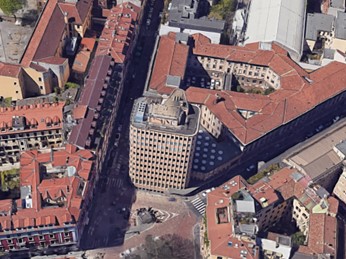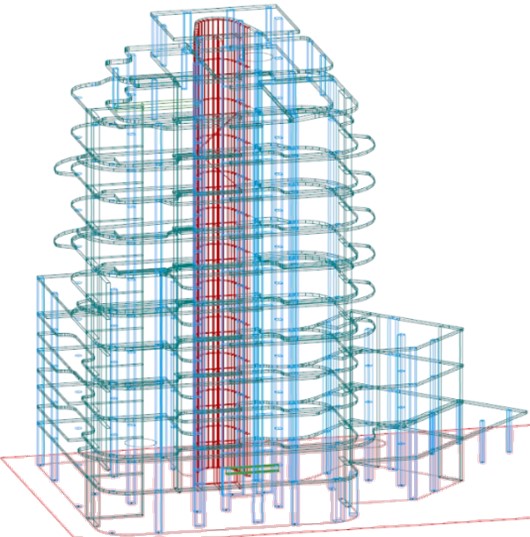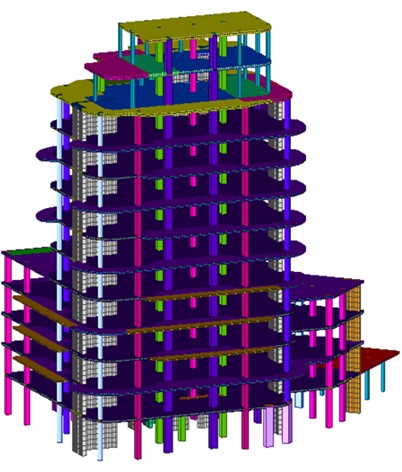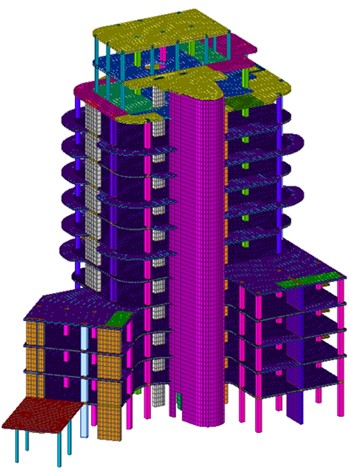AUTORE: Dott. Ing. Gianluca Manzoni
TUTORS: Prof. Ing. Pietro Crespi, Dott. Ing. Michele Capè
AZIENDA: Studio Capè Ingegneria S.r.l.
MASTER: Master in “Progettazione Sismica delle Strutture per Costruzioni Sostenibili” a.a. 2022/2023
Lo scopo principale dell’elaborato di Master è quello di esaminare, dal punto di vista ingegneristico strutturale, la progettazione di un nuovo edificio civile ad uso residenziale nel centro di Milano.
L’edificio, costituito da una sovrastruttura di 12 piani fuori terra, verrà costruito in Largo Treves a Milano, al posto dell’esistente Torre progettata dall’architetto Arrigo Arrighetti a metà del XX secolo per ospitare alcuni degli uffici del Comune di Milano.
Il nuovo condominio di lusso, realizzato dalla società Stella R.E. S.r.l., si inserisce nella riconversione e riqualificazione dell’intera zona Brera, voluta dall’amministrazione milanese.
La progettazione strutturale del condominio Largo Treves di Milano ha richiesto l’utilizzo delle più recenti tecnologie costruttive, sia per far fronte alla particolare tipologia delle finiture di lusso che la committenza ha deciso di utilizzare, sia per via della particolare forma del fabbricato originario a cui ci si è voluti ispirare.
Viste 3D del modello ad Elementi Finiti (FEM)
Attraverso numerose riunioni di confronto e coordinamento con lo studio di architettura incaricato, si è proceduto a dimensionare e calcolare i vari elementi della parte strutturale dell’edificio, tramite l’ausilio di software di calcolo, secondo le Normative nazionali ed internazionali vigenti.
Sotto la stretta supervisione degli ingegneri più esperti del team sono stati valutati i carichi che la struttura deve sopportare per poi svolgere un dimensionamento più approfondito e valutarne quindi la relativa resistenza, cercando di ottimizzare le dimensioni, riducendo al contempo lo spazio occupato dalla struttura e il costo dell’opera.
In accordo con la committenza e lo studio architettonico incaricato, si è cercato di conferire semplicità, simmetria ed uniformità strutturale, riducendo al massimo pilastri cosiddetti in falso, discontinuità in elevazione e variazione di sezione della struttura; andando quindi ad utilizzare rivestimenti e finiture, rendendo esteticamente gradevoli i prospetti ed ottimizzando la distribuzione interna delle unità situate ai vari piani.
Importante è stato l’inserimento di un elemento a nucleo in cemento armato che costituisce il vano scale e gli ascensori, fornisce alla struttura una resistenza tridimensionale alle forze sismiche ed allo stesso tempo conferisce al sistema una rigidezza nettamente superiore a quella che si otterrebbe con semplici pareti isolate.
FOR INTERNATIONAL STUDENTS:
The main purpose of the following Master’s thesis is to examine, from a structural engineering point of view, the design of a new civil building for residential use in the center of Milan.
The building, consisting of a 12-storey superstructure above ground, will be built in Largo Treves in Milan, in place of the existing Tower designed by the architect Arrigo Arrighetti in the mid-20th century to house some of the offices of the Municipality of Milan.
The new luxury condominium, built by Stella R.E. S.r.l., is part of the conversion and redevelopment of the entire Brera area, strongly wanted by municipal administration of Milano.
The structural design of the Largo Treves condominium in Milan required the use of the most recent construction technologies, both to cope with the particular type of luxury finishes that the client decided to use, and due to the particular shape of the original building to which we wanted to inspire.
Through numerous discussion and coordination meetings with the architectural firm in charge, the various elements of the structural part of the building were dimensioned and calculated, with the aid of calculation software, according to the national and international regulations in force.
Under the strict supervision of the team’s most experienced engineers, the loads that the structure must bear were evaluated in order to then carry out a more in-depth sizing and therefore evaluate its relative resistance, trying to optimize the dimensions, while reducing the space occupied by the structure and the cost of the work.
In agreement with the client and the architectural studio in charge, an attempt was made to confer simplicity, symmetry and structural uniformity, minimizing so-called false pillars, discontinuity in elevation and variation of section of the structure; thus going to use coatings and finishes, making the elevations aesthetically pleasing and optimizing the internal distribution of the units located on the various floors.
The insertion of a reinforced concrete core element which forms the stairwell and the lifts, provides the structure with three-dimensional resistance to seismic forces and at the same time gives the system a much higher stiffness than that which would be obtained with simple isolated walls.




